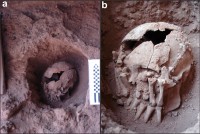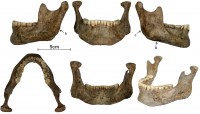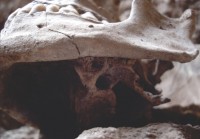 A severed skull and hands found in a rock shelter in east-central Brazil in 2007 is the oldest known instance of decapitation in the Americas. Radiocarbon dating of a fragment of cranial bone returned an age range of 9,100-9,400 years before the present. The oldest known decapitation in North America was found in Windover Pond, Florida, and is 8,120–6,990 years old. The decapitation previously thought to be the oldest in South America dates to 3,000 years ago. It was discovered in the Peruvian Andes, as have all other similar archaeological decapitations, so until now the practice in South America was thought to have originated among the ancient Andean peoples. The discovery of a decapitated head in Brazil that is not only older than the Andean beheadings but is older than the North American ones to boot upends that theory.
A severed skull and hands found in a rock shelter in east-central Brazil in 2007 is the oldest known instance of decapitation in the Americas. Radiocarbon dating of a fragment of cranial bone returned an age range of 9,100-9,400 years before the present. The oldest known decapitation in North America was found in Windover Pond, Florida, and is 8,120–6,990 years old. The decapitation previously thought to be the oldest in South America dates to 3,000 years ago. It was discovered in the Peruvian Andes, as have all other similar archaeological decapitations, so until now the practice in South America was thought to have originated among the ancient Andean peoples. The discovery of a decapitated head in Brazil that is not only older than the Andean beheadings but is older than the North American ones to boot upends that theory.
Geographically, the archaeological record of North America and Mesoamerica shows a more widespread occurrence of decapitation compared to South America, with cases occurring from the Arctic to southern Mexico. Our findings suggest that South America had the same spatially widespread distribution observed for North America, making the occurrence of decapitation widespread across the whole continent since the beginning of the Holocene. In addition, they confirm that the vast territorial range of decapitation behavior described in ethnohistorical and ethnographic accounts for the New World has deeper chronological roots.
 This burial is the last of 26 unearthed at the Lapa do Santo rock shelter in Lagoa Santa, Brazil, during excavations between 2001 and 2009. It was found about 22 inches under the surface in a circular grave 16 inches in diameter. Inside the grave was a skull with its articulated mandible and the first six cervical vertebrae. Both right and left hands were positioned in a fascinatingly symmetrical tableau. The right was placed over the left side of the face, fingers pointing down towards the chin. The left hand was over the right side of the face, fingers pointing up towards the forehead. Evidence of wear on the teeth and cranial morphology indicates the deceased was a young adult male.
This burial is the last of 26 unearthed at the Lapa do Santo rock shelter in Lagoa Santa, Brazil, during excavations between 2001 and 2009. It was found about 22 inches under the surface in a circular grave 16 inches in diameter. Inside the grave was a skull with its articulated mandible and the first six cervical vertebrae. Both right and left hands were positioned in a fascinatingly symmetrical tableau. The right was placed over the left side of the face, fingers pointing down towards the chin. The left hand was over the right side of the face, fingers pointing up towards the forehead. Evidence of wear on the teeth and cranial morphology indicates the deceased was a young adult male.
 Cut marks were found on the mandible, cheekbone the C6 vertebra and the right radius. The marks on the right hand indicate a sharp tool was used to detach the hand from the arm. The marks on the mandible and cheekbone appear to have been left during the cutting away of soft tissues, while the cuts to the vertebra were a result of severing the neck. A fracture in the atlas bone of the neck was likely caused when it was hyperextended and then pulled up. The atlas was also rotated 42 degrees, probably the result of it having been twisted to the side. This is strong evidence of postmortem decapitation.
Cut marks were found on the mandible, cheekbone the C6 vertebra and the right radius. The marks on the right hand indicate a sharp tool was used to detach the hand from the arm. The marks on the mandible and cheekbone appear to have been left during the cutting away of soft tissues, while the cuts to the vertebra were a result of severing the neck. A fracture in the atlas bone of the neck was likely caused when it was hyperextended and then pulled up. The atlas was also rotated 42 degrees, probably the result of it having been twisted to the side. This is strong evidence of postmortem decapitation.
 Burial 26 also upends the widely accepted belief that heads were taken and displayed as war trophies, an unmistakable signifier of military dominance. Results of stable isotope analysis of the head matched the strontium isotope signature of other remains found in the rock shelter, so this person was local, not a captured enemy. Add to that the unique and deliberate positioning of the skull, vertebrae and hands and the decapitation appears to have been a funerary ritual, and a complex one at that.
Burial 26 also upends the widely accepted belief that heads were taken and displayed as war trophies, an unmistakable signifier of military dominance. Results of stable isotope analysis of the head matched the strontium isotope signature of other remains found in the rock shelter, so this person was local, not a captured enemy. Add to that the unique and deliberate positioning of the skull, vertebrae and hands and the decapitation appears to have been a funerary ritual, and a complex one at that.
The earliest burials at Lapa do Santo are 10,300-10,600 years old, and in this first phase people were buried intact in shallow graves capped by limestone blocks. The second phase began around 9,600 years ago and involved extensive modifications of the bodies. They reduced the mass of the body by various means — dismemberment, defleshing, burning — and then buried what was left following ritual strictures. Burial 26 is from the second phase. Archaeologists believe this was a means for Archaic hunter-gatherers, who had no funerary monuments or grave goods, to develop elaborate rituals and explore symbolism using the dead body itself.